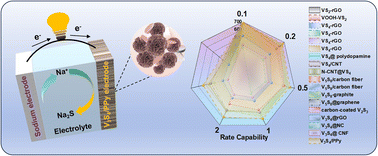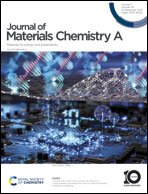V3S4/PPy nanocomposites with superior high-rate capability as sodium-ion battery anodes†
Abstract
Vanadium sulfides have been generally identified as one of the promising anode candidates for sodium ion batteries (SIBs) yet still suffer from serious capacity decay. Herein, we introduced a typical conductive polymer polypyrrole (PPy) as a buffer matrix to construct V3S4/PPy nanocomposites. Notably, PPy with high conductivity not only serves as a substrate to support V3S4, but also effectively disperses around the nanoflower-like V3S4, enhancing the ion transport rate and thereby improving the conductivity of energy storage. The unique structure of V3S4/PPy results in exceptional electrochemical performance, including a high reversible capacity of 619 mA h g−1 after 100 cycles at 0.1 A g−1 and remarkable rate capability (585 mA h g−1 at 2 A g−1 and 535 mA h g−1 at 5 A g−1) when used as an anode for SIBs. This performance is highly competitive with those of most of the vanadium sulfide-based anode materials reported to date. Additionally, the results of reaction kinetics indicate that the electrochemical reaction is mainly dominated by a pseudocapacitive charge storage process. This work opens a novel direction for designing high-performance vanadium sulfide anodes for sodium-ion storage.



 Please wait while we load your content...
Please wait while we load your content...